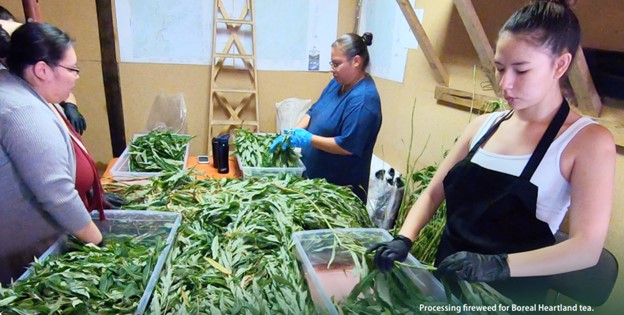Every aspect of Boreal Heartland Herbal Products’ business is about the place it comes from and the people who live there. Boreal Heartland is an Indigenous business based in Air Ronge, SK. From the beginning, the goals have been simple: provide sustainable income opportunities for the community, showcase the abundance and value of boreal forest plants, and be environmentally and socially sustainable.
Boreal Heartland began in 2017 as a division of the Keewatin Community Development Association (KCDA) and has remained true to its roots as a community economic development initiative.
“We were looking for ways to help industrial sectors develop in Northern Saskatchewan,” explains Randy Johns, manager of Boreal Heartland and CEO of KCDA. “When we came across the non-timber forest products sector, we thought there was room for development.”
As the name implies, non-timber forest products (NTFPs) are produced naturally in forests and can be harvested without cutting down trees. While the economic wealth of Canada’s forests has long been measured by the value of the trees that can be harvested, NTFPs are a somewhat hidden resource that contributes millions of dollars to Canada’s economy every year.
Johns says one of his first exposures to NTFPs was in 2016, when the Saskatchewan Herb and Spice Association brought Gerald Le Gal from Quebec to speak at an event in La Ronge. “He talked about non-timber forest products and that was when I realized there’s potential here.”
KCDA started working with the Saskatchewan Trade and Export Partnership (STEP) to identify potential products and markets. They developed a business plan and worked with Western Economic Diversification (now Prairies Economic Development Canada) to conceptualize the business and how they might develop.
“We also figured out that it’s better to do value-added products as opposed to bulk,” explains Johns. “Tea was a good way to get into it because it’s a fairly easy process: you dry the plants, you grind them, then you blend them into teas.” Their best-selling blend is a dark savoury tea made from fireweed leaves and wild mint.
From an economic development perspective, Johns says the benefits of value-added are obvious. For example, when they make fireweed into tea, they get 10 times more for it than they do when they sell it to the bulk market. “We have to put more work into it,” he concedes, “but the work is all done by people who contribute to the local economy.”
Between a quarter and half of their revenue goes to the harvesters. “This is all wildcrafted, so it’s all picked by hand. We’ve tried to set our prices so that a person can make $100 a day harvesting. We want to make sure people are getting value for their work and that the product is valued.”
In 2018, Ag-West Bio approached Boreal Heartland to do a presentation at Innovation Place. Following that introduction, in 2020 Johns and some of his colleagues participated in an agri-value market training program offered by Ag-West Bio (through the ABIC Foundation) called Beyond Entrepreneurship: Building an Agri-Value Business.
“That really was a great program,” says Johns. “It gave us the basics about how to set up a brand, set up your product financing, figure out your business plan, marketing, and so on. There were a number of small businesses in the course, and it was really good for start-ups, particularly in the value-added sector.”
Boreal Heartland began selling its products to specialty food and health stores, primarily in the Prairies. They also made a deal with Federated Co-operatives Limited to co-brand two of their teas, which are available in Co-op retail locations.
They recently hired Red River Indigenous Brands, a food and beverage broker from Regina. “They got us a national distribution deal with Purity Life, so we’re scaling up our harvest to meet the anticipated sales,” says Johns.
They’re also developing new products. In addition to teas and dried mushrooms, they’re working on some dried soup mixes and test marketing a line of boreal spices. “Because these spices will be new to people, I worked with a couple of chefs to develop recipes and suggestions about how to use them,” says Johns.
A line of ready-to-drink tea is presenting a new challenge: what do you put them in?
“We want something that’s sustainable, and aluminum cans are the easiest to recycle. So, we’ll either need to go somewhere to get our product put in cans or we will have to make the investment to do it ourselves,” says Johns.
There are other businesses in northern Saskatchewan that harvest and process NTFPs (primarily wild rice) and Johns predicts growth in this sector. He would like to see more research into the health benefits and chemical makeup of boreal plants, and research into sustainable wildcrafting and small-scale agriculture practices.
Developing the capacity in their own community means something; their location is an important part of their brand, and unlike traditional agricultural commodities, Johns says boreal NTFPs will not benefit from genomics research and technology related to large-scale harvesting.
“The fact that we’re an Indigenous organization and we have a connection to the land is really important to us and important to our philosophies and how we approach things,” he explains. “We can’t just do it to make a profit.”
